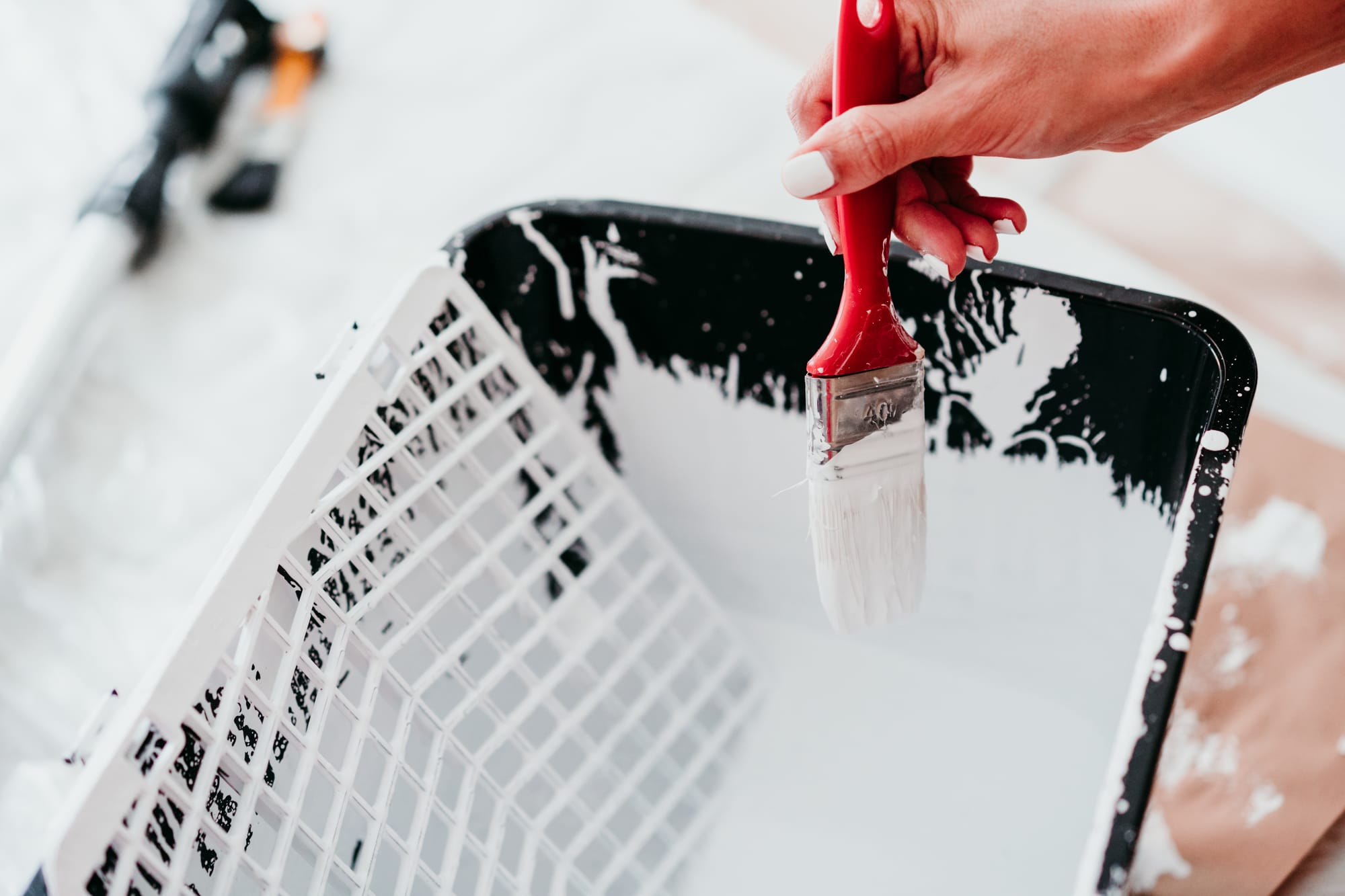Do You Always Need Two Coats of Paint?

Key Features
- Two Coats Offer Better Durability: A second coat strengthens the finish and extends the lifespan of the paint.
- One Coat May Work with Premium Paints: High-end products, like Behr Marquee, offer enhanced pigment concentration for better coverage.
- Preparation and Conditions Matter: Proper priming, sanding, and drying time between coats ensure a smooth, professional result.
Do You Always Need Two Coats of Paint?
It’s a common question: Do you always need two coats of paint? The answer isn’t as cut and dry as you might think. In some cases, you can get away with a single coat, but more often than not, two coats provide the best finish and durability. There are many factors to consider—like surface type, color change, and the quality of the paint you’re using. Let’s break down when a second coat is necessary and when it might be okay to skip it.
Why Two Coats of Paint Is Often Recommended
There’s a reason most professionals swear by two coats of paint: It’s about achieving both even coverage and longevity. A single coat can leave you with patchy areas, visible brush marks, and uneven colors—especially with darker or more saturated tones. Here are some reasons why two coats are typically recommended:
- Better Coverage: One coat often isn't enough to cover imperfections or old paint colors. A second coat ensures a smooth, even finish.
- Color Depth: Rich, bold colors like deep blues, reds, and greens almost always need two coats to achieve their full vibrancy.
- Durability: A second coat strengthens the finish, making it more resistant to scratches, stains, and peeling over time.
When you invest time and effort into a paint job, it makes sense to ensure it lasts—and two coats give you that peace of mind.
Things to Know
- Premium paints can achieve one-coat coverage but still benefit from a second layer for added durability.
- Surface preparation is key—proper priming and sanding ensure even application and adhesion.
- High-traffic areas require two coats to prevent early wear and tear.
- Temperature and humidity affect paint drying, so allow proper drying time between coats.
- One coat may suffice for similar color changes, but bold transitions usually need two.
When One Coat of Paint Might Be Enough
While two coats are generally the gold standard, there are instances where one coat can be sufficient—especially if you plan carefully and use the right materials.
- Using High-Quality Paint: Some premium paints, like Behr Marquee or Sherwin-Williams Infinity, are designed to offer one-coat coverage. These paints have higher pigment content and thicker formulations, making them more effective at covering surfaces.
- Similar Color Matching: If you’re painting over a wall that’s already a similar color, one coat might be enough to refresh the space without needing a second layer.
- Primed Surfaces: Painting over a properly primed surface often requires fewer coats, especially if the primer is tinted to match the topcoat color.
That said, even in these situations, a second coat can still improve the overall finish and extend the life of the paint.
Factors That Influence the Number of Coats Needed
Several factors play into whether you’ll need one or two coats of paint. It’s important to assess these conditions before starting your project.
- Surface Texture: Rough or porous surfaces, such as bare drywall or stucco, absorb paint more quickly and typically need a second coat.
- Color Transition: Going from dark to light (or vice versa) almost always requires two or more coats to cover the old color fully.
- Paint Type: Flat paint tends to offer better coverage in a single coat than glossier finishes like satin or semi-gloss, which may need a second layer to achieve uniformity.
- Environmental Conditions: Humidity and temperature can affect paint drying and coverage, sometimes making two coats necessary for the best results.
How to Know If a Second Coat Is Needed
Sometimes it’s hard to tell whether one coat is enough. Here are some signs that your wall might need another layer:
- Visible Streaks or Brush Marks: If the first coat leaves behind streaks or uneven sections, a second coat can smooth things out.
- Patchy Coverage: If parts of the wall appear lighter or darker than others, the paint hasn’t covered the surface evenly.
- Color Bleed-Through: If the old color is still showing through after one coat, it’s time for another layer to block it out.
- Inconsistent Finish: Different lighting conditions can highlight flaws in a single coat. A second coat helps create a more polished and professional look.
In Our Experience
"In our experience, applying two coats of paint provides peace of mind and long-term benefits. We’ve found that while high-quality one-coat paints can save time, a second coat often adds that extra layer of polish and durability. Skipping the second coat might work in low-traffic areas, but for important spaces, it's usually worth the effort."
The Right Way to Apply Two Coats
If you decide to go with two coats (and you probably should), here’s how to get the best results:
- Allow Proper Drying Time: Make sure the first coat is completely dry before applying the second. Rushing the process can lead to streaks and peeling. Most paints need at least 2-4 hours to dry between coats, but check the manufacturer’s guidelines.
- Use Quality Tools: High-quality brushes and rollers can reduce streaks and uneven coverage, making both coats look better.
- Sand Between Coats (if needed): Light sanding between coats can smooth out imperfections and help the second layer adhere better, especially for wood surfaces or trim.
Can Two Coats Save You Money in the Long Run?
Although two coats of paint may seem like an extra expense upfront, they can save you money in the long run. A second coat provides better protection against wear and tear, meaning fewer touch-ups and repaints down the road. Additionally, high-traffic areas—like hallways and kitchens—benefit from the added durability of a second coat. Skipping that second layer could lead to visible wear sooner, costing more in maintenance.
The Verdict: Do You Always Need Two Coats of Paint?
So, do you always need two coats of paint? No—but most of the time, it’s the smarter choice. One coat can work in certain situations, such as light touch-ups or premium one-coat paints, but two coats will almost always give you a more durable, polished finish.
If you’re painting a space you care about, whether it’s a high-traffic area or an accent wall, don’t skip the second coat. The extra effort pays off in both appearance and longevity, giving your space that flawless finish you’re after.
Do You Have Questions? Give Us A Call With Any & All! 503-389-5758
-
People Also Ask:
Is it always necessary to apply two coats of paint?
No, while two coats are recommended for most projects, some premium paints and color matches may allow for just one coat.
What factors determine if two coats of paint are required?
Factors such as surface texture, color change, type of paint, and environmental conditions affect the need for a second coat.
How can one coat of paint be effective?
Using high-quality one-coat paints, painting over primed surfaces, or matching a similar color may make a single coat sufficient.
-
SUBSCRIBE TO OUR BLOG: Stay informed with the latest in Painting and DIY projects by subscribing to Lightmen Painting. Get insights, tips, and more delivered straight to your inbox. We would also love to know what you would like to read about, leave thoughts on where we should go next. Interests, Topics, Ideas, all are welcome.
Get $3000 in personal assistant credits from Magic .com
^ Click Our Logo Above To Redeem ^
If your in the Portland, Or. area and need advice or a free no obligation estimate call us at 503-389-5758 or email scheduling@lightmenpainting.com
Shout Out:
Celebrating Medium: Your Insightful Resource for Home and Office Improvement
From the team at Lightmen Painting, we extend our highest praise to Medium for providing valuable content on the costs and considerations of office painting services. Just as we strive for excellence and transparency in our painting services, Medium offers readers practical advice on materials, costs, and best practices to help make informed decisions. Their commitment to sharing knowledge and fostering understanding aligns perfectly with our mission to deliver top-tier painting solutions that enhance professional spaces.
Thanks for stopping by Lightmen Daily! Stay tuned for more practical tips and expert advice on making your painting projects flawless, from wall to floor!
Definitions
- Two Coats of Paint: Applying two layers of paint for better coverage and durability.
- One-Coat Paints: Premium paints designed to provide complete coverage in a single application.
- Primer: A base coat that improves the adhesion and coverage of paint.
- Sanding Between Coats: Light sanding to smooth out the first layer for better adhesion of the second.
- Color Transition: Changing from a dark to light color, usually requiring multiple coats.
- Flat Finish: A matte paint finish that offers better coverage but less durability.
- Satin Finish: A smooth finish with a slight sheen, offering moderate durability.
- Humidity: Moisture in the air that can affect paint drying and coverage.
- High-Traffic Areas: Spaces like kitchens or hallways that need more durable paint.
- Durability: The ability of paint to resist wear, stains, and fading over time.
Lightmen Painting Serving: Portland, Tigard, Lake Oswego, Tualatin, West Linn, Milwaukie, Sherwood, Happy Valley, Oregon City, Beaverton, Hillsboro, Gresham -Trade Partners-

